

| home | animation | 2D/UI work | writing | etctera | about |
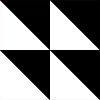 |
RISD Teaching Demo 2003I co-taught (with Cynthia Rubin) a class called "Building Digital Skills for Freshmen." This small set of animation demos were used to show students different animation techniques for beginning animators. |
 |
Sony Blendo Demos 2000-2001I worked on creating demos for Blendo, an embedded systems platform for the production, delivery, and presentation of interactive rich media applications. Work done in 2000-2001 at Sony Research Lab. NOTE: The plugin for these demos no longer exists; clicking on the image will bring up a page describing the demos. |
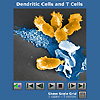 |
Cell Systems Initiative Animation 2000-2001The Cell Systems Initiative (CSI) was a multidisciplinary initiative based at the University of Washington. Its focus is on collaboration and education to understand the dynamic information control systems that operate within all living cells. I helped create some animated and interactive material for education and presentations in 2000-2001. This sample was built using Flash. Voice over by Lisa Jenschke at CSI. |
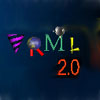 |
VRML: Cosmo Software Banner 1995-1998These VRML-based projects were all developed at Silicon Graphics with Tlo view these VRML demos, you need the Cosmo Player. It can be downloaded from: http://cic.nist.gov/vrml/cosmoplayer.html NOTE: It will work on IE or Firefox (Windows). |
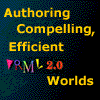 |
VRML: Siggraph Course material 1998This is the material for the course we (Dave Story, Geoff Brown and myself) presented at VRML '98 in Monterey and again at Siggraph '98 in Orlando. There are lots of examples of VRML worlds which illustrate the principles given in the course. It is available here as a downloadable WinZip file. NOTE: Unless credited otherwise, all the VRML demos in the course were built by me. |
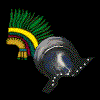 |
VRML: tenochtitlan experimental demo 1995The web site "Tenochtitlan" was built as a companion piece to the book "The VRML 2.0 Handbook," by Josie Wernecke and Jed Hartman. It incorporated many of the features available in VRML 2.0, including animation, sounds, and sensors. I did many of the book illustrations, and some of the individual demos. It was presented at the "Digital Bayou" at Siggraph and at Imagina in Monaco. The Tenochtitlan site was centered around a three-dimensional computer reconstruction of what the ceremonial precinct of the great Aztec capital of Tenochtitlan may have looked like before it was destroyed by Cortes and his Spanish conquistadors in 1521. Twenty one major archtitectural features or temple complexes, as well as sculptures and figures appeaedr in this model. Texture maps were used to help show what some of the murals and reliefs may have appeared. But these buildings alone are merely empty shells, insignificant without the names, associations, the myths, the ceremonies, the history... The addition of this material, via links to writings, sounds, images, and references helped illustrate the rich and complex lives of the Aztec people It was meant to be an integration of the walk-through experience with enough information in words, pictures, sounds and reference information to provide a context, a sense of what that world was. There was a narrative thread that provided a conjecture on what the exhanges between Moctezuma and Cortes may have been, from the first meeting up to the time when they had a heated exchange at the top of the Templo Mayor. NOTE: Not all the original links work properly; some bit rot has set in. |
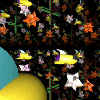 |
Geometry Center / Shape of Space Video 1995The Geometry Center created three important experimental videos visualizing recent work in mathematics. Computer animation was used to illustrate mathematical concepts and processes to a nonmathematical audience, without sacrificing mathematical depth. The Shape of Space is a book by Jeff Weeks, exploring the possible shapes of our universe. It suggests the possibility of a finite but boundless shape for our space. The Shape of Space video helps the viewer step through some of the important concepts presented in the book. Click on the image at left to launch a 511KB MPEG movie. The animation was done with custom programming. I worked as art director on this section. Please go to The Shape of Space page at the Geometry Center for more information. Directed by Tamara Munzner, Delle Maxwell. |
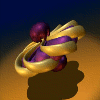 |
Geometry Center / Outside In Video 1992Outside In shows how a sphere can be turned inside out without poking a hole in it. You can see this short excerpt here; please note that it is a 388KB MPEG movie. This illustrates Bill Thurston's method for sphere eversion. There is much more about Outside In and sphere eversions at the Geometry Center site. This section was done with custom programming. I worked as art director on this section. Directed by Silvio Levy, Tamara Munzner, and Delle Maxwell. |
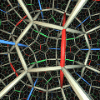 |
Geometry Center / Not Knot Video 1991This is an excerpt from the video Not Knot. A recent theorem of Bill Thurston states that most knots carry the structure of hyperbolic geometry. This video is a guided tour of this theorem-showing knots, the complementary spaces of knots, and into the hyperbolic structure of that space. You can go to the Geometry Center website to view some of the still frames, and to get more information. I worked as the art director, and did some of the animation using Softimage software. This section was done by Charlie Gunn, who made all these sections using custom programming. The excerpt is a 886KB MPEG movie with sound. Directed by Charlie Gunn and Delle Maxwell. |
|
|
Pacific Data Images 1988This short animation was something I did for fun when I worked at PDI. The animation was done using the PDI proprietary software. The background animation was a mathematical function written by Paul Heckbert. There is no sound. The size of MPEG file is 512KB. |
|
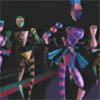 |
Pacific Data Images 1988This animation was done for HBO Video Jukebox. It won a Gold Award from the Broadcast Designer's Association, and a Northern California Emmy Award nomination in in 1988. It was created using the PDI proprietary software. There is no sound. The size of the MPEG file is 1.647MB. |